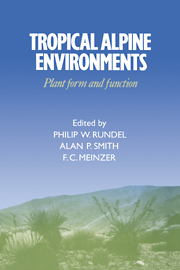Book contents
- Frontmatter
- Contents
- List of contributors
- Preface
- 1 Introduction to tropical alpine vegetation
- 2 Tropical alpine climates
- 3 Páramo microclimate and leaf thermal balance of Andean giant rosette plants
- 4 Comparative water relations of tropical alpine plants
- 5 Cold tolerance in tropical alpine plants
- 6 Anatomy of tropical alpine plants
- 7 Environmental biology of a tropical treeline species, Polylepis sericea
- 8 Morphological and physiological radiation in páramo Draba
- 9 Sediment-based carbon nutrition in tropical alpine Isoetes
- 10 Functional significance of inflorescence pubescence in tropical alpine species of Puya
- 11 Turnover and conservation of nutrients in the pachycaul Senecio keniodendron
- 12 Soil nutrient dynamics in East African alpine ecosystems
- 13 An overview of the reproductive biology of Espeletia (Asteraceae) in the Venezuelan Andes
- 14 Population biology of Mount Kenya lobelias
- 15 Population biology of Senecio keniodendron (Asteraceae), an Afroalpine giant rosette plant
- 16 Population dynamics and flowering in a Hawaiian alpine rosette plant, Argyroxiphium sandwicense
- 17 Plant form and function in alpine New Guinea
- 18 Alpine herbivory on Mount Kenya
- 19 Biotic interactions in Hawaiian high elevation ecosystems
- 20 Tropical alpine ecology: progress and priorities
- Index
15 - Population biology of Senecio keniodendron (Asteraceae), an Afroalpine giant rosette plant
Published online by Cambridge University Press: 21 October 2009
- Frontmatter
- Contents
- List of contributors
- Preface
- 1 Introduction to tropical alpine vegetation
- 2 Tropical alpine climates
- 3 Páramo microclimate and leaf thermal balance of Andean giant rosette plants
- 4 Comparative water relations of tropical alpine plants
- 5 Cold tolerance in tropical alpine plants
- 6 Anatomy of tropical alpine plants
- 7 Environmental biology of a tropical treeline species, Polylepis sericea
- 8 Morphological and physiological radiation in páramo Draba
- 9 Sediment-based carbon nutrition in tropical alpine Isoetes
- 10 Functional significance of inflorescence pubescence in tropical alpine species of Puya
- 11 Turnover and conservation of nutrients in the pachycaul Senecio keniodendron
- 12 Soil nutrient dynamics in East African alpine ecosystems
- 13 An overview of the reproductive biology of Espeletia (Asteraceae) in the Venezuelan Andes
- 14 Population biology of Mount Kenya lobelias
- 15 Population biology of Senecio keniodendron (Asteraceae), an Afroalpine giant rosette plant
- 16 Population dynamics and flowering in a Hawaiian alpine rosette plant, Argyroxiphium sandwicense
- 17 Plant form and function in alpine New Guinea
- 18 Alpine herbivory on Mount Kenya
- 19 Biotic interactions in Hawaiian high elevation ecosystems
- 20 Tropical alpine ecology: progress and priorities
- Index
Summary
Introduction
Senecio keniodendron (Asteraceae) is an abundant and widespread giant rosette species endemic to the alpine zone of Mount Kenya (lat 0°), Kenya. Along with Senecio brassica, it forms a dominant component of the alpine plant community, and shows a high degree of morphological convergence with giant rosette genera in other tropical alpine areas (Hedberg & Hedberg 1979; Smith & Young 1987; Smith, Chapter 1). Here we summarize studies of S. keniodendron population biology carried out between 1977 and 1985, and briefly compare these results with those both for S. brassica, and for the convergent Andean genus Espeletia (Asteraceae).
Senecio keniodendron occurs most commonly on upper slopes and ridges from c. 3700–4600 m elevation. Adult densities generally range from 1 to 10 plants per 100 m2, with greatest densities on talus slopes between 4000 and 4200 m. The mean height of S.keniodendron plants is significantly positively correlated with slope angle (Figure 15.1; r = +0.60; p < 0.001). Senecio keniodendron is replaced by S. brassica on lower slopes and valley floors; S. brassica has a lower elevational range than S. keniodendron – c. 3400–4400 m. The upper limit of growth for S. keniodendron (4600 m) may be due to a combination of drought and freezing stress (see also Perez 1987, on Andean Espeletia). Figure 15.2 shows the surface response curves for the densities of S. keniodendron (p < 0.04) and S. brassica (p < 0.01) im the Teleki Valley, relative to elevation and slope.
- Type
- Chapter
- Information
- Tropical Alpine EnvironmentsPlant Form and Function, pp. 273 - 294Publisher: Cambridge University PressPrint publication year: 1994
- 9
- Cited by



